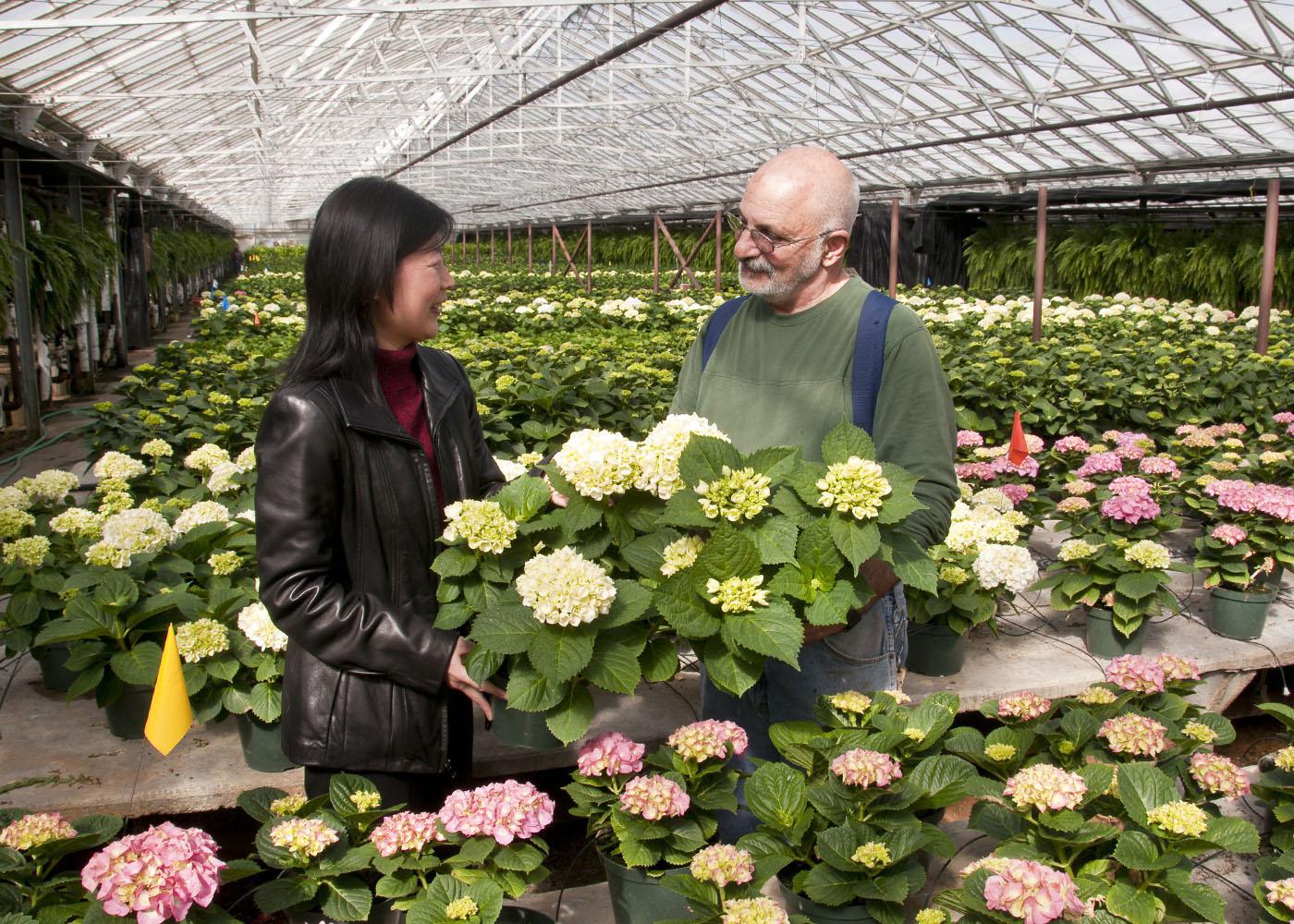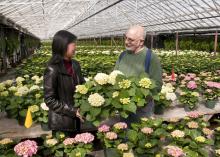Information Possibly Outdated
The information presented on this page was originally released on April 22, 2010. It may not be outdated, but please search our site for more current information. If you plan to quote or reference this information in a publication, please check with the Extension specialist or author before proceeding.
Management study affirms hydrangea crop's potential
By Patti Drapala
MSU Ag Communications
KOSCIUSKO – The hydrangeas that were mainstays in grandma’s yard are making a comeback, and Mississippi State University research may help commercial growers shed production problems.
Hydrangeas are an important crop for commercial growers in many states and could gain ground in Mississippi greenhouses because of Guihong Bi’s cultivation study. A research horticulturist with the Mississippi Agricultural and Forestry Experiment Station, Bi said many greenhouses and nurseries could use this information to diversify their operations and perhaps improve the overall quality of their stock.
“The knowledge obtained from this research can help growers decrease their production costs, reduce their nitrogen fertilizer inputs, minimize nitrogen runoff, improve plant quality and possibly improve grower profits,” Bi said.
Hydrangeas are a group of ornamental shrubs prized for their large flowerheads and long stems. One of the more popular species is Hydrangea macrophylla, commonly known as the florist hydrangea. The flowers can vary from white to various shades of blue, pink, red and purple. The ability of the plants to absorb aluminum in the soil can affect the color of non-white flowers.
Consumers often buy hydrangeas for Valentine’s Day, Easter and Mother’s Day. To have them ready for sale, growers use a process called forcing. Growers manipulate the plants to obtain blooms within a marketing window by controlling their growth with different treatments, including leaf shed, or defoliation, cold storage and forcing in the greenhouse.
Bi’s goals were to develop methods to promote defoliation without affecting nutrient storage and to identify a fertilization program that reduces excessive vegetative growth, allows plants to use nitrogen efficiently and improves flowering performance. She consulted with several greenhouse operators on the project.
“Dr. Bi sees what we are trying to do, and she puts together a protocol that addresses some of the problems we have in our production,” said Mark Terkanian, general manager of Natchez Trace Greenhouses in Kosciusko. “I’m a grower, and she is the scientist. It keeps us both on track to solve problems.”
Natchez Trace Greenhouses is now producing dormant hydrangea plants, instead of buying them from the West Coast. Terkanian said he has seen demand for hydrangeas increase in the last five years with no sign of slowing down.
“It costs more than $5 per plant to ship dormant hydrangeas from the West Coast,” he said. “You can see why we needed an alternative to buying dormant plants.”
The labor-intensive process to produce hydrangeas at Terkanian’s facility starts in April. Terkanian buys unrooted cuttings from Oregon and plants them in containers. The plants are placed in greenhouses or shaded fields to develop their root systems and go through summer’s vegetative growth phase.
The plants start to develop flower buds in late summer and autumn before they are placed into a cooler. This cold storage phase takes from six to 10 weeks. The hydrangeas are then taken out of the cooler and placed in the greenhouse for forcing into bloom.
Terkanian was interested in minimizing production time and cost. He invited Bi to use his facility for her experiment with chemical defoliants and foliar fertilization sprays.
“As a grower, I want to know how things work, particularly if we want to mimic the natural blooming process for hydrangeas,” he said.
In her experiment, Bi treated plants with different rates of nitrogen during their vegetative growth in summer. She applied different chemical defoliants and nitrogen fertilizers in the fall.
Bi is the first researcher to investigate the effectiveness of foliar urea applications in fall, either before the chemical defoliants are applied or in conjunction with defoliant applications on growth and flowering performance of florist hydrangeas.
Initial results have indicated that some treatments do not visibly injure plants but actually improve their ability to store nitrogen for bloom development during forcing.
“The information from the study also may apply to other greenhouse and nursery crops,” she said. “However, the response of plants to defoliants and fertilization practices is affected by many variables, and growers should conduct proper testing before incorporating any method into production practices.”








